







October 2023September 2024













October 2023September 2024





The North Luangwa Conservation Programme Socio-economicandBiodiversityImpactReportis the first report to present the collective socioeconomic and biodiversity impact of the North Luangwa Conservation Programme and associatedpartnershipsonanannualbasis.

It is the first report of this kind for the North Luangwa Conservation Programme (NLCP), presentingtheconservationpartnerships’impact as a vital sector and land use to sustain livelihoods and improve human well-being, in line with the NLCP’s mission of “Linking LivelihoodsandLandscape”.
Thereportreflectsthepartners’biodiversityand socio-economic contribution made through protected area management, law enforcement, tourism,andlivelihoodactivitiesintermsofthe resultant value added to improved natural resource management, jobs supported, salaries generated, livelihood activities supported, contributiontoGDP,andtaxesgenerated.
Itishopedthatthroughthisreport,theNLCPand Biodiversity Economy is increasingly recognised by the government, partners, and public and private sectors as a key enabler of sustainable livelihoods through protecting our natural resources as a critical provider of ecosystem services.
Central to this are strong accountable partnerships and relationships across the landscape in support of conservationcompatible rural economic development. The NLCPhasbuiltatruesenseofpartnershipwith thecommunitylivingtheretoprotecttheentire North Luangwa ecosystem, whilst supporting andleveragingresponsiblelivelihoodsthrough partnerships.
I would like to thank the NLCP partners for contributing and committing to this initiative, which seeks to increase transparent communicationandimpactfulinvestment.
A special thanks to the USAID HEARTH Luangwa Livelihood Conservation Activity for supporting this process within the North Luangwalandscape.

~EdSayer,ConservationDirectorFZSZambia


CHW – Community Health Worker
CMP – Collaborative/Conservation Management Partnership
CRB – Community Resources Board
DNPW – Department of National Parks and Wildlife
FZS – Frankfurt Zoological Society
GMA – Game Management Area
GMP – General Management Plan
HEARTH – Health, Ecosystems and Agriculture for Resilient, Thriving Societies
LLCA – Luangwa Landscape and Conservation Activity
HWC - Human Wildlife Conflict
HWCoex – Human-Wildlife Coexistence
IMET – Integrated Management Effectiveness Tool
IUCN – International Union for Conservation of Nature
MERL – Monitoring, Evaluation, Research & Learning
NL – North Luangwa
NLL – North Laungwa Landscape
NLNP - North Luangwa National Park
NP – National Park
NLCP – North Luangwa Conservation Programme
PA – Protected Area
SDG - Global Sustainable Development Goal
SMAG – Safe Motherhood Action Group
USG – United States Government
VAG – Village Action Group
Casual job Paid ad hoc piecework
Cocoba
Community Based Natural Resource Management
Community Camp
Community Scouts
Community Resources Board
Concession camp/Park Concessions
Conservation Education and Mini-change Groups
Direct Use Value
Community Conservation Bank – micro-finance interlinked with improved natural resource management principles
A people-centered approach to managing natural resources while also developing a community. It is implemented to ensure sustainable use and protection of the environment through appropriate capacity enhancement and empowerment mechanisms.
Tourism camp owned by the community in a Chiefdom with camp attendant appointment through the Community Resource Board, managed through support of the NLCP.
Under DNPW supervision responsible for law enforcement in Game Management Areas, appointed through the Chiefdom.
Decision-making structure within Chiefdoms in Game Management Areas. Only the secretariat receives payment, whilst the other board members are voluntary.
Tourism camp managed by private operator, with a focus on local economic development. Commercial agreement signed with and managed through DNPW.
School clubs (environmental education) and adult groups (mini-change) following a conservation education curriculum.
Direct use value is the economic value of goods and services that people can directly use from an ecosystem, such as harvesting timber, fish, or water, or enjoying scenic beauty.
Fixed Term Job Paid position for a fixed short-, medium-, or long-term. Seasonal jobs also included.
Governance/CBNRM Effective natural resource management and decision-making within a Chiefdom
HWCoex
Law Enforcement
Learnerships/Internships
Natural Resource Management Activity
Natural Resource Management Participants
Non-use Value
Regenerative Tourism
Human-wildlife coexistence activities seeking to pro-actively manage, mitigate and adapt activities to reduce conflict between human and wildlife using the same space.
Job and activities improving natural resource management protection. Various programmes within this activity operating in the Park and the GMA areas include: REPU - Rhino & Elephant Protection Unit; NLCP K9 - Canine Unit; FLU - Fenceline Unit (responsible for the integrity for the rhino sanctuary fence); RMU - Rhino Monitoring Unit; IIU - Intelligence and Investigation Unit.
Placement within an organisation to gain experiential learning.
Any activity enabling responsible benefit-sharing because of the natural environment, e.g. beekeeping, fisheries, natural forest management.
Community members actively participating in natural resource activities improving/sustaining livelihoods. These members might or might not have received formal training/upskilling in the past year.
The non-use value of the environment is the worth that people place on ecosystem services that they do not directly use, but still consider to affect their well-being.
Travel practice that aims to leave destinations in a better state than they were found.
Tourism Non-comsumptive tourism activities.
Training / Vocational Training
Training during the reporting period to upskill skills in a particular area of community-based natural resource management/protection.
Use Value refers to the tangible features of a commodity (a tradeable object) which can satisfy some human requirement, want or need, or which serves a useful purpose.
Volunteer/Enumerator/ Intern
Key responsibility in supporting the implementation of a specific thematic area. Either unpaid (volunteer) or through a small stipend (e.g. enumerator, intern).
The North Luangwa Socio-economic and Biodiversity Impact Report was funded by the USAID HEARTHLuangwaLandscapeConservationActivity(LLCA).
TheImpactReporthasbenefitedfromdataandstrategicinputsfromlocalstakeholders,notably,the North Luangwa Conservation Programme (Frankfurt Zoological Society and Department of National Parks and Wildlife). It has also benefited from feedback from the North Luangwa Chiefdoms’ Community Resource Boards, Tourism and Safari Hunting operators, USAID HEARTH partners, with insightsreceivedfromtheSustainableFinanceCoalition.
Photocredits:Unlessotherwisestated,photographsaretakenbyManaMeadowsPhotography.


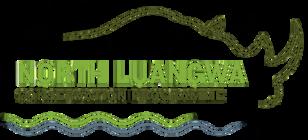


Citation: Frankfort Zoological Society. 2024. North Luangwa Conservation Programme’s SocioEconomic and Biodiversity Impact Report, October 2023–September 2024.
The purpose of this Impact Report is to provide an overview of the North Luangwa Conservation Programme’s (NLCP) socio-economic and biodiversity impact for the period October 2023September2024.


TheNLCPSocio-EconomicandBiodiversityImpactReport(NLCPImpactReport)servesasaprototype aimed at promoting accountable reporting and communication by NLCP partners. It highlights conservation as a key driver of socio-economic development and a means of sustaining livelihoods within the landscape, through effective natural resource management practices. This inaugural NLCP ImpactReportactsasapilotinitiativetoenhancetheexistingdatacollectionsystemandsupportsthe developmentofacomprehensivesocio-economicandbiodiversityimpactmodelforthelandscape.
The NLCP Impact Report aims to highlight:
The exceptional and significant values and features of the North Luangwa Landscape.
Conservation-compatible business models and diversified income streams resulting from these values and associated land-use planning.
The effectiveness of socio-economic and biodiversity management in achieving positive landscape outcomes.
The collective impact of partnerships in driving scalable results.
It is important to acknowledge that this inaugural NLCP Impact Report significantly underestimates the socio-economicandbiodiversityimpactoftheconservationsector.Thisisduetothelimitedparticipation ofvariouspartnerspresentinthelandscapewhoareyettocontributetothisreport,andwillhopefullydo so in future. The data collection systems for partners reporting on socio-economic and biodiversity impactswillbecontinuouslyimprovedandexpandedontoenhancereportinginthefuture.
Thedocumentwillreporton:
Jobs
Salaries(NLCP)
Activities
Biodiversityandlawenforcementimpact
ContributiontoGDP&taxes
USAIDHEARTHindicators
Thesemetricswillbeevaluatedatthefollowing levels:
NorthLuangwaLandscapelevel
Chiefdomlevel
FrankfortZoologicalSociety(FZS)level
(includingjobs,salaries,andcontributions totaxesandGDP)
USAIDHEARTHindicators
The NLCP Impact Report is limited to measuring and communicating the Direct Use Value of the NLCP partnerships. It does not include Use and Non-UseValues,whichareessentialtohumanwellbeing and will need to be addressed in future assessments.

ThefollowingarekeyconsiderationsfortheNLCPImpactReport:

Promote Conservation as a Viable Land Use: Demonstrate that conservation is a crucial and sustainable land use practice for improving natural resource management and promoting human well-being, while highlighting the exceptional value and significance of the North Luangwa landscape.
Showcase Collective Impact: Illustrate the collective impact of partnerships in enhancing conservation management and achieving positive livelihood outcomes.
Promote Transparency and Accountability: Foster transparency in impact reporting among partners, and promote accountability for actions and outcomes.
Monitor Trends for Effective Management: Track trends over time to inform management interventions, ensuring continuous improvement in efficiency and effectiveness
Report to Donors and Investors: Provide clear reporting to donors and investors on the impact of their investments in the region.

Law Enforcement and Natural Resource Protection: Efforts to ensure the protection of natural resources and the enforcement of conservation laws within the landscape.
Livelihoods and Local Economic Development: Focus on creating jobs, providing training, supporting enterprise value chains, promoting learning opportunities, and contributing to the overall economic development of local communities.
Biodiversity Monitoring and Management: Ongoing efforts to monitor and manage biodiversity to maintain ecosystem health and protect endangered species.
Conservation Infrastructure Management: The development, maintenance, and management of infrastructure that supports conservation activities and sustainable land use.

ConsistentMetricsforReporting:Reportingwillbebasedonconsistent,measurablemetrics,suchas:number ofhectaresunderimprovedmanagement,numberofjobscreated,numberofpeoplebenefitingfromimproved economicoutcomes,convictionratesforwildlifecrime,growthratesofkeyspeciesofinterestandincreasesin cropyields,amongothers.
FieldValidation:Dataandfindingswillbevalidatedthroughfieldverificationtoensureaccuracyandreliability.
QualitativeMonitoring:Knowledge,Attitude,andPractice(KAP)surveysandfocusgroupdiscussionswillbe conductedforqualitativemonitoring,providinginsightsintocommunityperceptionsandbehaviors.

Evidence-BasedData:Thedatausedisevidence-basedandcanbevalidatedforaccuracyandreliability.
WillingnesstoParticipate:Thereisanopennessandcommitmenttoparticipatefromallrelevantstakeholders.
ConsistentMonitoringandTracking:Monitoringandtrackingtoolsareinplaceandcontinuouslyupdatedto ensureconsistentdatacollectionandreporting.
AddressingDataGaps:Gapsindatamonitoringwillbeaddressedbyimprovingthemonitoringsystemacross partnerorganisations,ensuringa"singlesourceoftruth"foralldata.
BuildingUnderstandingandTrust:Overtime,theunderstanding,trust,andbuy-inforusingtheimpacttoolwill grow,fosteringbettercollaborationanddatausage.
EvidenceforInvestmentDecisions:Thereportwillserveastheevidencebaseforinvestmentinconservation andkeylanduses,guidingfutureinvestmentsandpromotingaccountablepartnerships.

The NLCP is an internationally recognised conservationprogrammerespectedforitshandson, adaptive approach to conservation. It places localcommunitiesattheheartofsuccessfullargescale landscape conservation, emphasising the beliefthattheresilienceoflivelihoodsreflectsthe healthoftheecosystem.
The NLCP was established in 1986 as a partnership between the FZS and Zambia’s Department of National Parks and Wildlife (DNPW).Itsmissionistoprotectandmanagethe North Luangwa National Park (NLNP) in northeasternZambia.
The NLNP is located in the northern part of the Luangwa Valley, within the Mpika District of Zambia's Muchinga Province. The park lies betweenlatitudes11°25'Southand12°20'South, and longitudes 31°45' East and 32°40' East. Its eastern boundary follows the Luangwa River, while its western boundary runs along the MuchingaEscarpment.
The park is part of the larger Luangwa Valley ecosystem, which spans a catchment area of 144,000 km². This ecosystem is characterised by diverse features, including the Muchinga Escarpment,LuangwaValley,complexvegetation patterns, and the Luangwa River. The park is accessible year-round by both air and road, with thenearesttown,Mpika,located80kmaway.


The NLCP has evolved into a highly successful African landscape conservation initiative. Initially focused on managing the 4,636km² NLNP, it has transitioned from a park-specific project to a landscape-level conservation effort of global significance. Its current operational area now spans over 22,000km² within the greater North Luangwa landscape.
TheNorthLuangwaNationalPark(NLNP)boastsnumerous significantattributes:
Itisoneofthelastremaining pristineandexpansive wildernessareasinAfrica.
The park serves as a majorcatchmentarea for the LuangwaRiver,encompassingalargeportionofthe MuchingaEscarpmentandthreeperennialrivers.
Ithasahighdensityand richbiodiversityofflora.The Luangwa Valley is recognised as one of the world’s centersof plantdiversity,withNLNPshowcasingthe bestexampleofundisturbedescarpmentmiombointhe valley.ItisalsodesignatedasanIUCN CenterofGlobal PlantDiversity.
The park supports significantpopulationsoffauna, hostingtheonlyareaintheLuangwaValleywithafull complementofhistoricalspecies.
Keywildlifeincludesnotablepopulationsof elephants, African buffaloes, hippos, lions, and leopards, alongsideendangeredandrarespeciessuchas black rhinos,Cookson’swildebeest,andAfricanwilddogs.
NLNPstandsasa modelforeffectiveprotectedarea management in Zambia, demonstrating the positive outcomes achievable through investment, enhanced human resource capacity, and robust management systems.

1.PristineWilderness.
2.Majorcatchmentareaforthe LuangwaRiver.
3.Highdensityandrich biodiversityofflora(924species).
4.Significantpopulationsoffauna.
5.Agoodmodelforeffective protectedareamanagementin Zambia.

North Luangwa National Park: 4,636km²
Munyamadzi GMA: 3,300km²
Mukungule GMA: 1,900km²
Musalangu GMA: 8,686km²
Lumimba GMA: 4,500 km²

through Community Resource Boards (CRBs) andassociatedVillageActionGroups(VAGs).
The remaining intact areas and estimated populationperchiefdomarepresentedinthe tablebelow.


The NLCP strives to support the human and wildlife populations of the North Luangwa landscapethrough:
Ecologically sound protected area management.
Responsible and conscientious community-based natural resource management(CBNRM).
Wildlife-based enterprise development that delivers extensive employment opportunities.
Robust and adaptive front-line law enforcement operations, aimed at reducing wildlife crime and illegal trade both within northern Zambia and across internationalborders.
Conservation-related education and awareness within its associated rural communities.
NLCP firmly believes that the communities living within and around the North Luangwa landscape hold the key to its future success and sustainability. The program is deeply rootedinthelocalcontextwhilemaintaining a broad global perspective. It embodies a committed grassroots culture while recognising its international responsibility as a refuge for biodiversity, a significant global carbon sequester, and a provider of critical ecosystem services at local, regional, and continentallevels.

NLCP’s approach to stakeholder engagement is guided by its mission: Linking Livelihoods and Landscape, which is supported by four strategic goals:
To implement robust and adaptive largelandscapeenforcementtacticsthat:
Securetheintegrityofwildlife, habitats,andecosystems. Safeguardthemfromharm.
Sustaintheirecologicalservicesforthe benefitoftheglobalcommunity.
To empower our teams and neighboring communities and the wider Zambian civil society by:
Implementingcreativeandbeneficial initiatives.
Deliveringeducationopportunities. Supportingthedevelopmentof wildlife-basedenterprises.
Tofostereffectiveandpositivechangethrough: Focusedmessagingtocommunicate withstakeholdersandpartners. Buildingmeaningfulconnections.
To establish a clear and enduring organisational andfinancialstructuresupportedby: Efficientsystems.
Amotivated,mentallyandphysically healthyteam
NLCP is committed to strengthening partnerships among communities, government, and the private sector while fostering integrated planning and management within the following strategic focal areas:

2. Socio-economic integration & job creation
Value chains, jobs, and livelihoods through wildlife economy (forestry, fisheries, hunting, carbon trading) tourism, conservation agriculture, waste economies, internships, gender mainstreaming, youth development, health, environmental education and workplace development.
3. Sectoral land use planning & management
Policyandplanning,landuseplanningandzonation,landtenurecertificates,cross-sector programs(e.g.mining,climatechange,health,agriculture,forestry).
4. Strengthening partnerships & governance structures
Tieredgovernancearrangements,stakeholdermappingandengagement,communication plan, diverse conservation agreements including management plans and stewardship agreements.
² ² species of interest (fauna and flora) and Human-Wildlife Coexistence (HWCoex) management.
5. Mobilise resources & optimise investments
Donorresourcemobilisation,innovativefinancingthroughnature-basedfinancing:carbon, bonds,credits,catchmentfunds,HWCinsuranceandsocio-economicimpactassessment.
6. Strengthening data & knowledge management
Monitoring,evaluation,researchandlearning(MERL),dynamicdatamanagementsystems, bestpracticeguidelines,citizenscienceandmanagementeffectivenesstrackingtools.
Central to this approach is unlocking and formalising private, community and public interests and innovative financing solutions in the GMA areas, securing ecosystem services while fostering sustainable and equitable livelihood benefits through Conservation Management Partnerships. For this reason, transparent impact reporting is essential to support responsible and accountable NLCP partnerships.

This section summarises the combined socio-economic impact of activities in the NLNP and five surrounding chiefdoms. The fixed-term and casual jobs are provided primarily through the North Luangwa Conservation Programme (FZS, DNPW, CRBs) and key partnerships, including select tourism concessions, safari hunting operators, and implementing partners under the USAID HEARTH LLCA programme. In the future, it is anticipated that a broader analysis of conservation-related employment anditsmultipliereffectswillbeincludedasmorepartnersadopttheImpactTrackingToolfortheNLCP ImpactReport.
Over the last year, as detailed in the below graphics, the landscape has provided at least 838 jobs impactingroughly4,609peopleacrossthelandscape.Thejobsprovidedarethenbrokendownintothe four sectors, where jobs are associated with either park operations (168 jobs), law enforcement (323 jobs), tourism (233 jobs) or governance/livelihood activities (114). The majority of these positions are filledbymen(82,7%).
In addition to employment opportunities, the NLCP and partners provide opportunities for capacity buildingthroughtrainingandparticipationinactivities.Thetrainingandparticipationgraphicprovides an overview of the NRM activities as well as training conducted within the North Luangwa landscape, categorisedacrossvariousthematicareas.




Key Clarifications for data relating to the North Luangwa Landscape
Underestimation of biodiversity and socio-economic impact: Data captured from FZS, CRBs, some DNPW data, USAID HEARTH partners, and select safari and tourism operators represents a partial picture.
Broader safari and tourism operators: Additional safari and tourism operators should be included in future reports. Exclusion of broader sectors and partners in GMA areas: The report does not yet include data from broader sectors and partners operating in the GMA areas. This will be crucial in achieving a collective vision and goal of land use protection and sustainable livelihoods.
Contribution to GDP and taxes: Currently, only FZS contributions to GDP and taxes are included. Multiplier impact not quantified: The total multiplier impact has not been quantified, as it is pending further input from partners.
Single data source unavailable: A single, unified source of data for monitoring and information is currently not available. Revenue/income at GMA level: Revenue and income at the GMA level are not quantified or readily available. Donor contributions: Contributions from broader donors across various sectors and partners, beyond NLCP, are not quantified. Government budgets: Government budgets for each Chiefdom and the North Luangwa landscape have not been presented.
Management costs of GMA areas: Core conservation management costs for GMA areas are not included in this report. Data available for the various landscape scales (landscape, NLNP, chiefdoms) is not always consistent. Certain information such as training & vocational training is presented as an aggregated value at the NLL level only, but will be disaggregated per chiefdom in future impact reporting.

The USAID HEARTH LLCA aims to enhance the resilienceandwell-beingofbothecologicaland human communities that depend on natural resources in the Luangwa Valley. This initiative leverages robust public-private-community partnerships and enterprise development to ensure the sustainable management of natural resources.Itfocusesonimprovingkeyecological metrics, such as the population size of critical species and the effective management of land areas,whilesimultaneouslyfosteringcommunity development.
The LLCA's overarching goal is to ensure that localcommunitiesintargetedareasbenefitfrom:
Improvednutritionandaccesstosafewater.
Enhancededucationalservices.
Diversified and sustainable conservationcompatiblelivelihoods.
The Theory of Change assumes that the biodiversity in the Luangwa Valley can be conserved through an integrated approach that addressesmanyoftheindirectdriversandissues that lead communities to alter land use or use natural resources unsustainably or illegally, but which also improves local community resilience and well-being, including health and socioeconomicopportunities.

Threehigh-levelstrategicapproacheswhichbuildon:(i)conservationcompatiblecommunityenterprises andlivelihoods,(ii)strengthenedNRMandprotectionand(iii)enhancedhumanwellbeing,asitrelatesto maternalandchildhealth,foodsecurityandnutritionandaccesstowaterandsanitation,willbeadopted.
ThesystemdiagrambelowdepictstheUSAIDHEARTHLLCAprogramme’sprojectactivitiesandreporting against the indicators. It specifically seeks to improve biodiversity, ecosystem services and human wellbeingthroughanintegratedOne-Healthapproach:


ThroughthesupportofUSAIDHEARTHLLCAandOAKFoundation,threeCommunityHubswere established in Nabwalya, Chikwa and Chifunda chiefdoms. The hubs provide the following services:mobilemoney,talktime,simregistration,bicyclehireservices,printing,anduseofthe community space for trainings, events and workshops.These hubs serve as socio-economic enablers/catalystswithinthechiefdoms,andthefollowingcanbereported:
KeystatisticsfromCommunityHubsinclude:
Bicyclerentals:Atotalof396rentals,with85bywomenand311bymen.
Printingandphotocopyingservices: 391 individuals utilisedtheseservices,with273 menand118women.
8088Mobilemoneytransactions(5940menand2148women).
Revenuegenerated:Theseactivitiescollectivelygenerated$3,266.06overtheyear.
Duringthereportingperiod,ZayoHubsuccessfullyfacilitatedvocationaltrainingsforthefirstcohort of46studentscomprisingof21femalesand25males,inChikwaandChifunda.Thereafter,another 50studentsweretrained,totalling96students(47F,49M).Thestudentsunderwenttraininginsix differentprograms:FoodProduction,FashionDesignandTextileTechnology,Automotive Engineering,CarpentryandJoinery,BricklayingandPlastering,andElectricalTechnology.


Crop Purchases:
SoyaBeans:Atotalof63,307kgpurchased.
Rice:Atotalof99,973kgpurchased.
CombHoney:150kgpurchased.
Farmer Recruitment and Support:
Poultry Farming: 200 poultry farmers recruited,with450chickensprocured.
HorticultureFarming:200horticulturefarmers recruited, with assorted vegetable seeds provided.
A total of 32,550 kg of seed inputs procured and distributed across two chiefdoms: Groundnuts (MGV 5): 12,000kg; soybeans: 12,000kg; rice: 4,500kg; cowpeas: 600kg; earlymaturingmaize:4,500kg;chillies:450kg.
Beekeeping Initiatives:
720 farmers recruited and trained in beekeeping.
5,000beehivesdistributed.
60farmersparticipatedinhoneyharvesting.
13beekeepinggroupsestablished.
This is an underrepresentation of the full scope of contributions. It is important to encourage partners to use an impact tool not only to demonstrate the value their contributions, but also to better coordinate and align conservation management and socio-economic contributions and development. More sector partners such as forestry, conservation agriculture, tourism concessions and safari hunting operators will be engaged for more inclusive participation and reporting infutureimpactreports.

Through the NLCP conservation is a major provider of employment in the chiefdoms surrounding NLNP.FZSprovided377jobsoverthereportingperiod.Thissectionprovidesadetailedoverviewof the FZS staff structure within the North Luangwa landscape, including data disaggregated to the chiefdom level. Contributions to taxes and salaries are also highlighted. Staff numbers and casual employment fluctuated during the reporting period, and future impact reports will include more accuratestatisticsandgraphsderivedfromthenewstaffandpayrollsystem.
Todateatotalinvestmentof:
$5,051,881hasbeenmadebyFZSintoinfrastructuredevelopment
aswellasanannualinvestmentof:
$8,834,000intoNLNPandneighbouringchiefdoms.
Thereare 16 Mini-Change groups foradultsand conservation clubs forschoolchildren across the landscape 1,022 primary school club members and 362 Mini-Change group membershavebeenengagedwithonvariousenvironmentaltopicsovertheyear.


TheNLCPpartnershipsarecommittedtogendermainstreaming,includingwomen,men,boysand girls in dialogues and activities. The aim is to ensure that the project not only contributes to conservation goals but also actively promotes gender equality and empowers women and men equally.
Keycomponentsofgender-sensitiveimplementationin conservationandlivelihoodprojectsinclude:
Equitableparticipationandrepresentation:Ensuringthe meaningfulparticipationofbothwomenandmenin decision-makingprocessesrelatedtoconservationand associatedlivelihoodactivities,aswellasinleadership rolesandcommittees.
Equitableaccesstonaturalresources:Facilitatingequal accessto,controlandresponsiblegovernanceover naturalresources.
Recognitionofgender-specificknowledge:
Acknowledgingandintegratingtheuniqueknowledge andperspectivesthatwomenandmenpossess regardingtheenvironmentandNRMandincorporating thisintoconservationandassociatedlivelihoodpractices andpolicies.
Capacitybuildingandtraining:Providingtargeted capacitybuildingprogrammesandtrainingopportunities thatcatertothespecificneedsandinterestsofboth womenandmen.
EconomicempowermentthroughresponsibleNRM: Promotingeconomicopportunitiesandincome-generating activitiesthatareaccessibletobothwomenandmen, therebyenhancingtheireconomicempowerment.
Addressinggender-basedviolenceandsocialnorms: Implementingmeasurestoaddressandpreventgenderbasedviolence,aswellaschallengingharmfulsocial normsandstereotypesthatmayhindertheeffective participationofwomeninconservationprojects.
Monitoringandevaluation:Incorporatinggenderdisaggregateddatacollectionandanalysisthroughout theproject'slifecycletoassessthedifferentialimpactsof conservationactivitiesonwomenandmen,andtoensure thatgenderequalityobjectivesarebeingmet.
PolicyAdjustments
Trained19NLCPstaff ingendermainstreaming
Trainingforlaw enforcementofficers
140Lawenforcementspouses visitedthepark
50Awarenessposters& manualsdistributed
Menstrualhygienemanuals distributed
15Peopletrainedintailoring washablepads(4M,11F)
Menstrualhygiene monitorstrained
11Menstrualhealthmonitors trained&appointed(2M,9F)
275Reusableproducts bought&distributed
200vulnerableyounggirls identified&advocacyforgirlsto stayinschool
Capacitybuildingofwomen inVAGcommitteesinChikwa &Chifunda
Dialogueswithtraditional healersaroundinheritance& landrights

Theoutputsforconservationlawenforcementin NLNPbetweenOctober2023andOctober2024 highlightsignificanteffortsinprotectingwildlife andcombatingillegalactivities.
ThecombinedeffortsoftheAPFoot,IIUnits, andNLCPK9Unitresultedinatotalof19,971 man-days dedicated to conservation activities. These units conducted 1,279 operations, addressing397incidentsreportedtothecontrol room. Notable achievements include the removalof146wiresnaresandtheconfiscation of 184 firearms, demonstrating proactive measures to reduce poaching and illegal hunting.Additionally,1,572kgofbushmeatwas recovered,indicatingasubstantialefforttocurb theillegalwildlifetrade.
Theillegaltimbertradeisanemergingthreat, andtheconfiscationof3,566piecesofillegal timberand17chainsaws,whilesignificant,may beanunderrepresentation,astimberproducts werenotsystematicallyrecordedpriorto2024.
Footpatrolscoveredatotalof 33,064km, ensuringextensivemonitoringofNLNP.
Outside the park, 121 roadblocks were established, and 24,460 vehicles were searchedfortimberandotherillegalwildlife products.
Theseeffortsresultedin 480arrests, withan impressive 77% conviction rate, showcasing the effectiveness of the legal process.
The patrols achieved approximately 78% coverageoftheNLparkand95%inthe rhinosanctuaryarea, reflecting a strong presenceandcomprehensivesurveillance.



AsummaryoftheNRMactivitiesandjobsfromthe NLCP and immediate partnerships are presented in this section for each chiefdom and NLNP. InformationwasobtainedfromtheNLCP,CRBand NLCP partners. It doesn’t represent the broader stakeholders and their contributions in the landscape, and is therefore an underrepresentationofthefullscopeofactivities, donations and socio-economic development support within each chiefdom. However, it is the intention to engage with partners and stakeholders to participate in chiefdom business planning with the CRBs and other community structures,tobetterinformeffectiveconservation and socio-economic planning, resource mobilisationandimpactreporting.


In2022,NLNPwasthefirstprotectedareainZambiato achieveIUCNGreenListaccreditation.Itis oneofonly five terrestrialsitesinAfricatoachieverecognitionfrom IUCN criteria for fair and effective conservation measures sinceintroductionofthestandardinAfricain 2014. This sets a benchmark for protected area managementinAfrica,whilstdeliveringonourMission statementof"LinkingLivelihoodstoLandscape".
This year, the NLNP underwent a management effectiveness assessment using the Integrated ManagementEffectivenessTool(IMET)andobtaineda scoreof60.35%.Ascoreofover50%isconsidered good and an indication of effective conservation management.Itishopedtobringthisscoreuptoover 70%intimeforthenext3-yearreviewwithfocuson sustainable financing, ecological monitoring and bringing the Landscape Integration Unit implementation and impact to scale. Management effectivenessisscoredagainstthefollowingcriteria:

Managementcontext –ScoreshowwellthePAhasunderstoodandincorporateditssignificant valuesandcontextintoitsplanningandactions.
Planning–ScorestheusefulnessandrelevanceoftheManagementPlanforeffectiveconservation management.
Inputs –Scoresfinancial,physicalandhumanresourcesavailablefortheimplementationofthe managementplan.
Process–ScorestheSOP’s,policiesandguidelinesavailableforteamsonthegroundtoimplement themanagementplan.
Outputs–ScorestheimplementationoftheManagementPlanworkplan.
Outcomes–Scorestheoverallachievementofprogrammeobjectives.
NLNP’sIMETscoringisbrokendownbelow:
Management Context
TheNLNPprovidesacoresourceofjobsandtrainingopportunities.Atotalof329jobsweresupported over the the reporting period, with a multiplier impact of 1,809 people. Volunteer and consultancy opportunities were also made available in the park over the year. Tourism products inside the park includeAmatololocommunity-ownedcampsiteaswellasprivateconcessions.





Key Clarifications for data for NLNP
Jobs are mostly FZS funded.
Two Tourism concession high-level only impact reports included.
One new concession agreement negotiated. Amatololo self-drive and self-catering tourism route. Open July-end October.
Mukungule GMA is located on the western boundary of the NLNP in Mpika District, NorthernProvinceofZambia.TheGMAcovers an area of 1,900 km². The majority of the boundary between Mukungule GMA and NLNP follows the Muchinga Escarpment. The Mukungule GMA and chiefdom share the sameboundary.
Mukungule GMA contains vital catchment areas for three of the Luangwa River’s most important perennial tributaries: the Mwaleshi, Lufila, and Munyamadzi rivers. In addition, Mukungule GMA includes other perennial streams such as Mufushi, Muneshi, Mushishe, Luswa, and Chipembele, which all drain into theLufila,Munyamadzi,andMwaleshirivers.
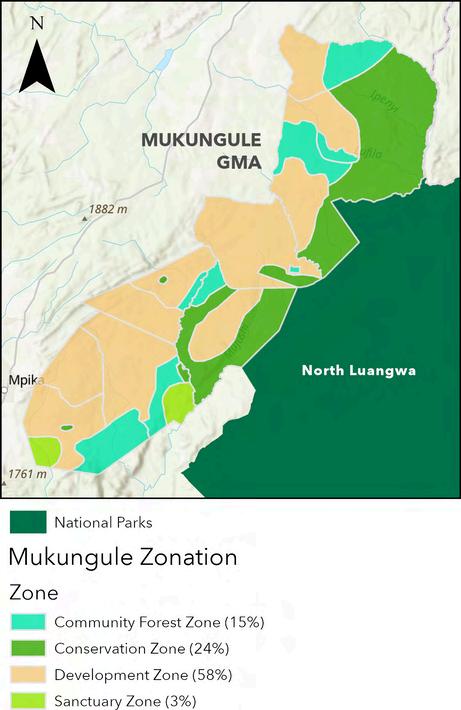
Zonation of Mukungule GMA/Chiefdom

Landcover map of Mukungule GMA/Chiefdom
The predominant vegetation type in the upper Muchinga Escarpment and its foothills is Miombo woodlands.MukunguleGMAissituatedontheupper Muchinga Escarpment, an area known for its diverse ecologicalimportance.
The GMA plays a dual role, combining human livelihood activities, such as agriculture, with its function as an integral part of the western habitat buffer for NLNP. The primary focus of Mukungule GMA is to harmonize sustainable natural resource conservation practices with the livelihood activities of local communities, ensuring long-term benefits for both the environment and present and future generations. The GMA has an estimated 5,332 households which is an estimated population of 29,436people.
Catchment areas for key rivers:
Encompasses the Mwaleshi, Lufila, and Munyamadzi rivers. These rivers play a crucial role in maintaining the flow and hydrological functionality of the Luangwa River.
Theseriversmaintainthepark’secological balance.
Perennial streams:
Home to streams like Mufushi, Muneshi, Mushishe,Luswa,andChipembele.
These streams flow into the Lufila, Munyamadzi, and Mwaleshi rivers, eventuallyfeedingtheLuangwaRiver.
Ensures a continuous water supply that sustainsbiodiversity.
Human-wildlife integration:
Combinesagriculturewithconservationto balance community needs and environmentalprotection.
Fertile soils and favorable vegetation support crop cultivation and livestock farming when paired with sustainable practices.
Wildlife refuge:
Provides critical habitat for a diverse range of wildlife species as part of the NLlandscape.
Mountain scenery: Features portions of theMuchingaEscarpment.
Wildlife hotspot:
Perennial rivers and streams attract game during the dry season, ideal for wildlife observation. Plateau species such as sable, blue duiker and blue monkeyfoundhere.
Tourism potential:
Village settlements offer opportunities for community-based tourism, benefitinglocallivelihoods.
Beekeeping:
Vegetation supports beekeeping, providing an additional income source forresidents.
Waterfalls:
Hosts two remarkable waterfalls — one on the Munyamadzi River and another ontheMwaleshiRiver.
The Samala Community Tourism Camp is open and functional, operating year-round. It is used by NLCP for workshops, staff activities, and partner bookings. The camp is community-owned and managed by NLCP.
A high-level impact report from one safari hunting operator has been received and incorporated into the data.
The transformation of the farm block is negatively altering the GMA footprint, with its biodiversity and socio-economic impacts yet to be quantified.
The development of Mano camp infrastructure is funded by KfW Development Bank. The community hub has been completed, but it is not yet functional.


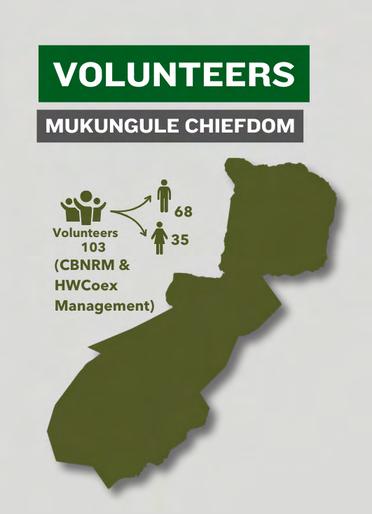


TheMunyamadziGMAislocatedinMpikaand LavushiMandaDistrictsofMuchingaProvince, Zambia,andspansanareaofapproximately 3,300km².ItissituatedbetweentheLuangwaand MuchingaEscarpment.
KeyfeaturesoftheMunyamadziGMAinclude: ItisborderedbythreeNationalParks:
NLNPonthenorth-easternboundary.
LuambeNationalParktotheeast.
SouthLuangwaNationalParktothesouth.
TheMunyamadziRiver,Luangwas2ndlargest tributarybisectstheGMA.
TheGMAplaysacrucialroleasabufferzone, wildlifecorridoranddispersalarea.Itfacilitates themovementandgeneticdiversityofwildlife betweentheparks,contributingtotheoverall healthoftheecosystem.

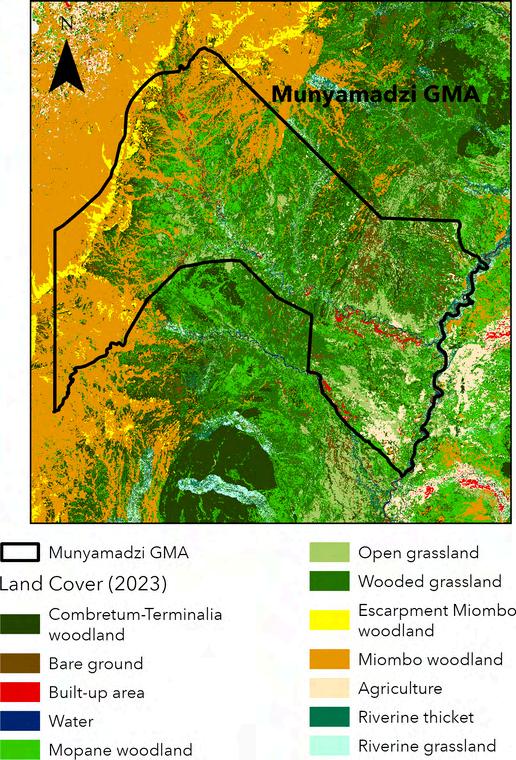
Nabwalya Chiefdom, which is part of the GMA, is strategically situated within this important ecological zone, adding value to the conservation and managementeffortsinthearea.
TheMunyamadziGMAishometoadiverserangeof habitats that support a rich variety of wildlife. These habitatsincluderiparianforests,Miombowoodlands, Combretum woodlands, Mopane woodlands, Munga woodlandsandgrasslands.Mostofthesehabitatsare in good condition, which contributes to the area's ability to support a wide variety of wildlife. These ecosystems also have immense potential for ecotourism,particularlyphotographictourism,whichcan promote sustainable conservation efforts while providingeconomicbenefitstothelocalcommunities.
TheprimarypurposeoftheMunyamadzi
GMA is to preserve, conserve, and protect various natural resources, including wild plants, wild animals, heritage sites, mineral resources and water resources. These efforts aim to ensuresocio-ecologicalbenefitsthatwill support both the present and future generations, balancing ecological sustainability with community development.

High Concentration of Wildlife & Good Big Game
TheGMAboastsahighdensityoficonicwildlife, includingelephantsandlions.
Visitorsarealmostguaranteedsightingsoffourof Africa'sBigFive
Rare and Endemic Species
Home to unique fauna, such as the Thornicroft’s Giraffe,aspeciesendemictotheLuangwaValley and has Zambias highest population of the endemicCooksonsWildebeest.
Rare fish species, such as the endangered cichlid Oreochromis mortimeri, add to the area's ecologicalsignificance.
Other rare species include the Lilian’s Lovebird, anendemicbirdspecies.
Diverse Natural and Cultural Heritage Resources
Features exceptional natural landmarks such as theMutinondoWaterfalls,aswellascavesandhot springs, which hold cultural and ecological significance.
Strategic Location and Connectivity
Munyamadzi GMA is one of the few GMAs surrounded by protected areas (Forest Reserve, North Luangwa, South Luangwa, and Luambe NationalParks).
This positioning enhances its role as a wildlife sanctuary, corridor, and dispersal area, contributing to genetic diversity and ecosystem stability.
Largest Hippo Concentration in the World
TheLuangwaRiver,whichrunsthroughtheGMA, supports unprecedented numbers of hippos, a globallysignificantecologicalfeature.
Diverse Natural and Cultural Assets
Munyamadzi is rich in both biodiversity and heritageresources,offeringopportunitiesforecotourism, cultural tourism, and sustainable development.




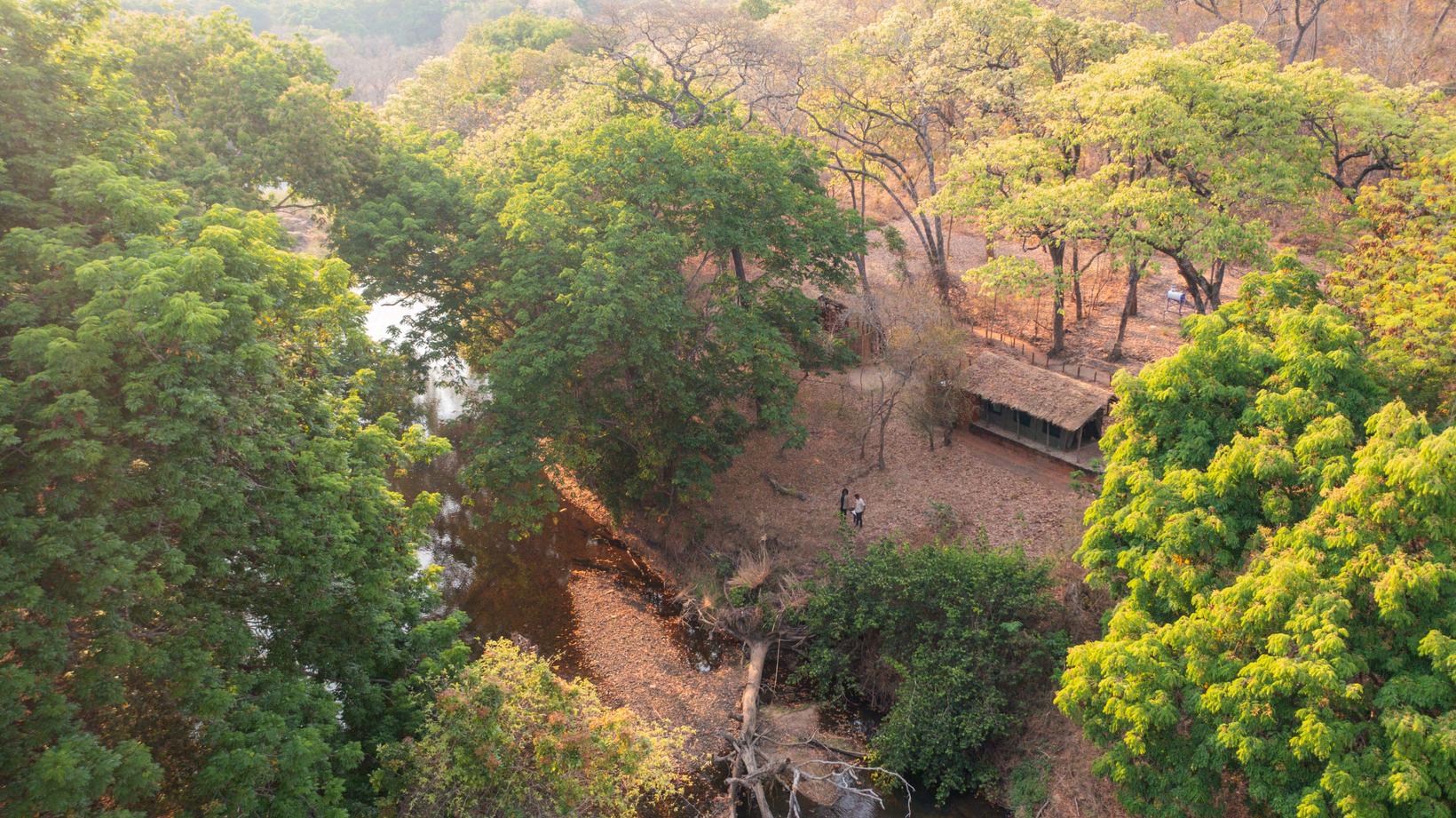
Mandalena Camp, Nabwalya.
Key Clarifications for data for Nabwalya Chiefdom
Mandalena Community Tourism Camp has been open and functional from July 2024, and hence low occupancies and revenue for this period. Open entire year. Community owned, managed by NLCP.
Poor accessibility (road access) and poor access to markets.
No Safari hunting during this reporting period, negatively impacting income, jobs, and livelihoods.
Community hub completed and functional to provide services e.g. mobile money, IT services, and renting out bicycles.
No current tourism concessions.
No current carbon or other nature based solutions.
Musalangu GMA is in Chama, Chasefu and Lumezi districts in the Eastern Province of Zambia.ItisoneofthefourGMAsthatprovide a buffer to the NLNP and is located at the southern tail end of the Great Rift Valley. It covers a vast area of 17,350km². Chifunda, Chikwa and Lundu Chiefdoms have an estimated 12,563 households which is an estimatedpopulationof69,096people.

Zonation of Musalanga GMA
The Muchinga escarpment is dominated by Miombowoodland.Amosaicofwoodlandand wooded grassland is spread across the valley floor dominated by Mopane in the east and mixed Munga and Miombo woodland in the west,withValleyRiverineforestalongthemajor watercourses.

A number of tributaries feed the Luangwa namely Luumbu, Kalinkhu, Mbwata, Kamphemba, Mwambwa in the north and Bazimu, Lupamazi, Lunzi, Luelo, Luvila and Lundaziinthesouth.Mostofthestreamsdryup in dry season leaving isolated pools of water along river-beds. The purpose of Musulangu GMA is to preserve and conserve the natural andheritageresourcesfortheenhancementof livelihoods of the local community and education, research and recreation for the presentandfuturegenerations.

Trans-frontier Conservation Importance:
Forms part of the Zambia-Malawi watershed, providing critical connectivity within the MalawiZambiaTrans-frontierConservationArea.
Diverse Ecosystems:
Features various vegetation types, including mountainous terrain, valley floors, and riverine habitats.
HostsahighdensityofDalbergiaspecies,treeswith significantcommercialvalue.
Rich Cultural and Historical Significance:
Home to heritage sites such as Chipyuzi, Kangulu, andKalimuliloHotSpring
IncludesuniquefeaturesliketheChamphunoCaves.
Scenic Attractions:
MuchingaEscarpmentofferspanoramicviewsofthe GMA.
Contains natural wonders like Kalimulilo and Mwambwa hot springs as well as Mwambwa River Gorge
Strategic Conservation Role:
The largest protected area in the Malawi-Zambia Trans-frontierConservationArea
The GMA has the longest stretch of the Luangwa Riverrunningthroughit.
Key Clarifications for data for Musalangu GMA
Mandalena Community Tourism camp open and functional from July 2024, and hence low occupancies and revenue for this period. Open entire year. Community owned, managed in partnership with NLCP.
Poor accessibility (road access) and poor access to markets. No Safari hunting during this reporting period, negatively impacting income, jobs, and livelihoods.
Community hub completed and functional to provide services e.g. mobile money, IT services, and renting out bicycles.
No current tourism concessions.
No current carbon / innovative financing streams





No current community tourism camps. Impact data from safari operator not available/included. Community hub completed and functional to provide services e.g. mobile money, IT services & renting out bicycles.





Ituba Community Tourism Camp open and functional. Used by NLCP for workshops/staff/partner bookings. The camp is seasonal and open July – mid-November. Community owned, managed in partnership with NLCP. Community Hub completed and functional to provide services such as mobile money, IT services, and renting out bicycles. One tourism concession high level impact report, from inside the GMA, is included. No safari hunting during this reporting period, negatively impacting income, jobs, and livelihoods. FZS/NLCP has carried Community Scout salaries and CRB governance support throughout.




Key Clarifications for data for Lundu Chiefdom
Currently no Community Tourism camps.
High-level impact report of safari operator included in job numbers & in landscape tourism contributions below.